Essay on Curriculum Development: Analysis and Improvements
VerifiedAdded on 2022/12/19
|9
|2134
|174
Essay
AI Summary
This essay delves into the realm of curriculum development, defining its significance in the 21st century and its role in shaping successful learners. The core of the essay comprises a critical analysis of the 'ITC0107 Basic Concepts of Information and Communication Technology (ICT) Qualification Outline,' an outcome-based curriculum for information technology. The analysis scrutinizes the curriculum's design, the learner-centered approach, and the process model employed. The essay also provides an overview of the curriculum's aims, objectives, assessment plans, and unit structures. Furthermore, it assesses the curriculum's strengths, such as its alignment with learner needs, and identifies areas for improvement, particularly in assessment methodologies and practical application of knowledge. The essay concludes by emphasizing the curriculum's effectiveness in teaching and learning information technology, while also suggesting enhancements to further enrich the learning experience.
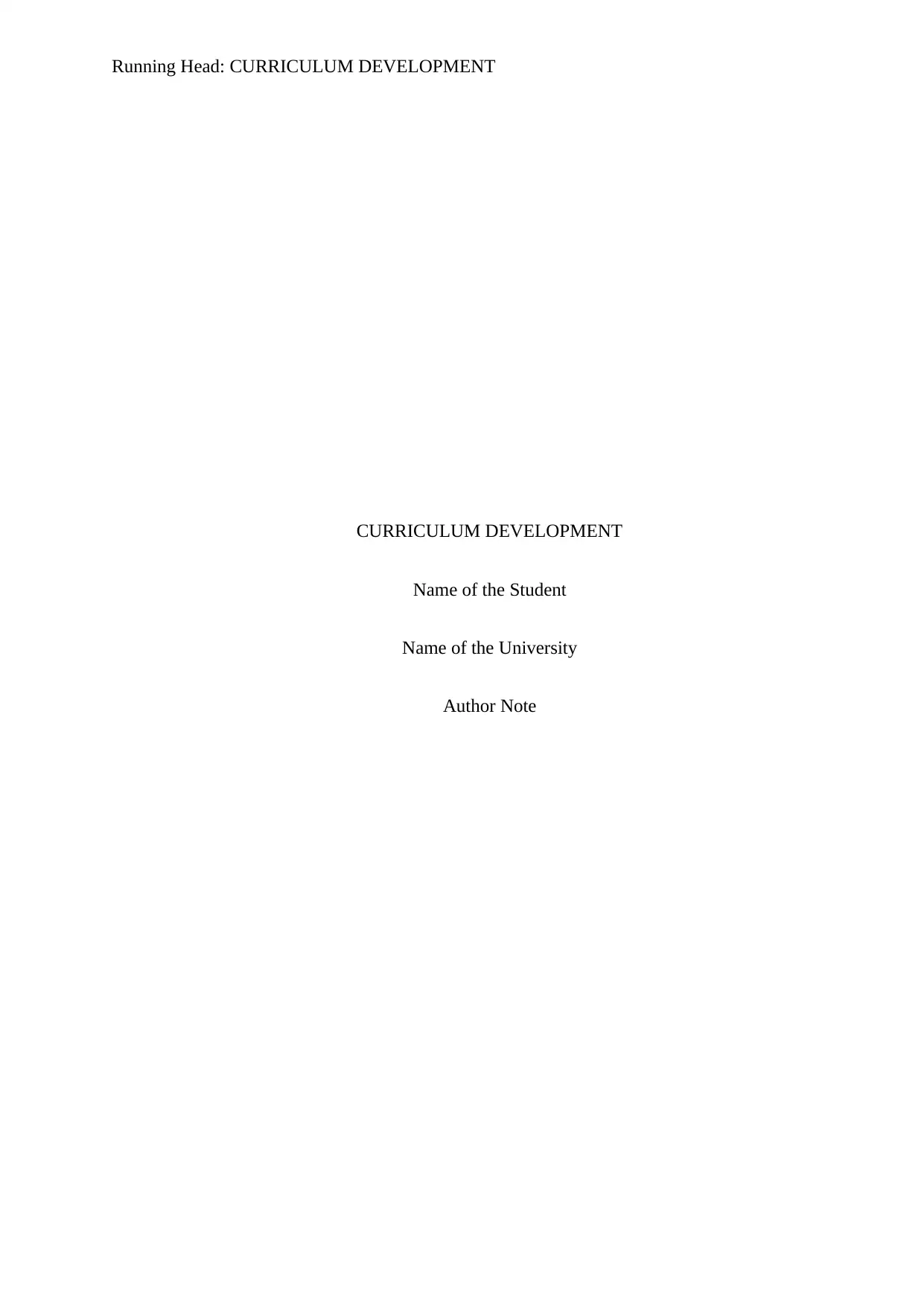
Running Head: CURRICULUM DEVELOPMENT
CURRICULUM DEVELOPMENT
Name of the Student
Name of the University
Author Note
CURRICULUM DEVELOPMENT
Name of the Student
Name of the University
Author Note
Paraphrase This Document
Need a fresh take? Get an instant paraphrase of this document with our AI Paraphraser
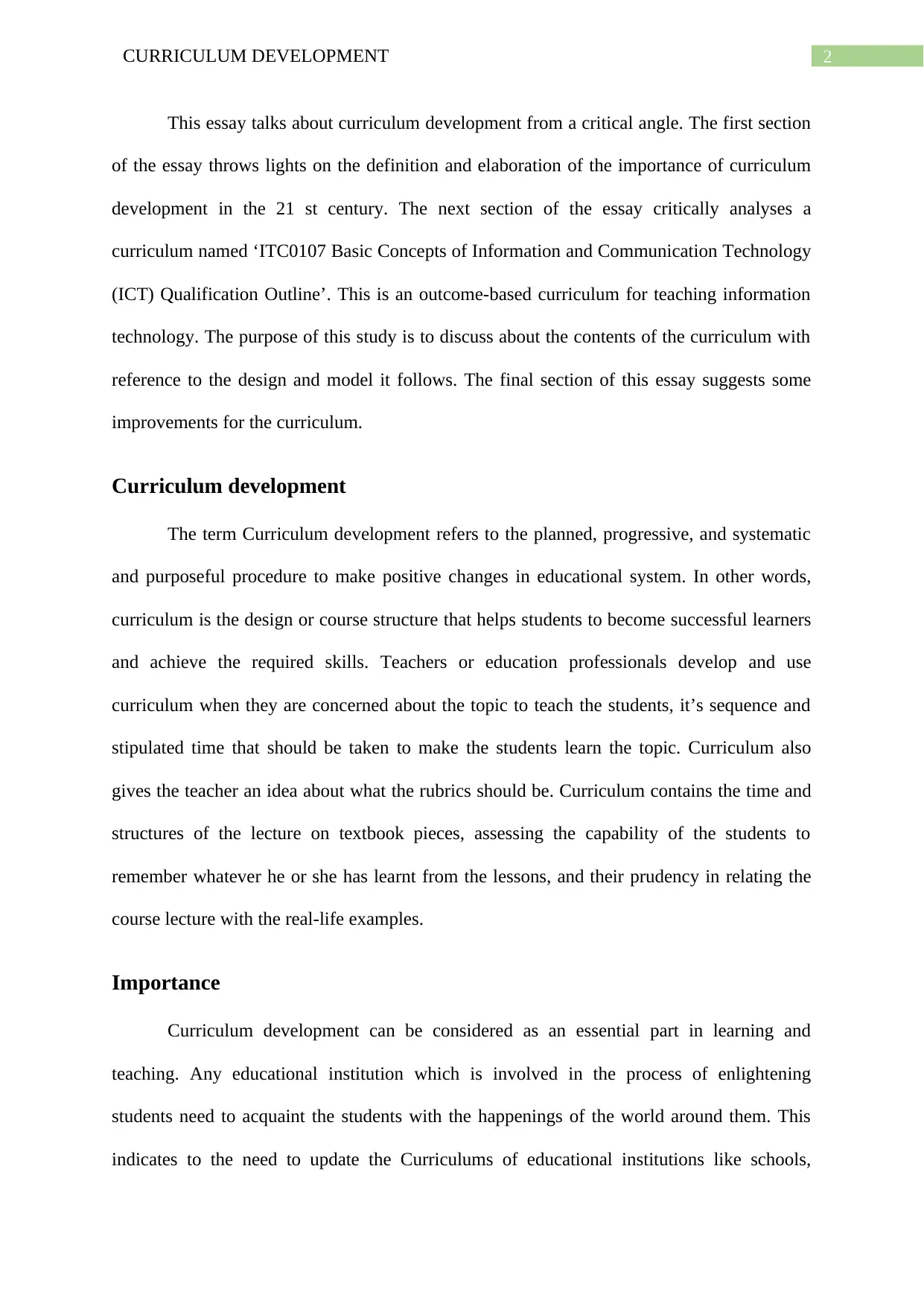
2CURRICULUM DEVELOPMENT
This essay talks about curriculum development from a critical angle. The first section
of the essay throws lights on the definition and elaboration of the importance of curriculum
development in the 21 st century. The next section of the essay critically analyses a
curriculum named ‘ITC0107 Basic Concepts of Information and Communication Technology
(ICT) Qualification Outline’. This is an outcome-based curriculum for teaching information
technology. The purpose of this study is to discuss about the contents of the curriculum with
reference to the design and model it follows. The final section of this essay suggests some
improvements for the curriculum.
Curriculum development
The term Curriculum development refers to the planned, progressive, and systematic
and purposeful procedure to make positive changes in educational system. In other words,
curriculum is the design or course structure that helps students to become successful learners
and achieve the required skills. Teachers or education professionals develop and use
curriculum when they are concerned about the topic to teach the students, it’s sequence and
stipulated time that should be taken to make the students learn the topic. Curriculum also
gives the teacher an idea about what the rubrics should be. Curriculum contains the time and
structures of the lecture on textbook pieces, assessing the capability of the students to
remember whatever he or she has learnt from the lessons, and their prudency in relating the
course lecture with the real-life examples.
Importance
Curriculum development can be considered as an essential part in learning and
teaching. Any educational institution which is involved in the process of enlightening
students need to acquaint the students with the happenings of the world around them. This
indicates to the need to update the Curriculums of educational institutions like schools,
This essay talks about curriculum development from a critical angle. The first section
of the essay throws lights on the definition and elaboration of the importance of curriculum
development in the 21 st century. The next section of the essay critically analyses a
curriculum named ‘ITC0107 Basic Concepts of Information and Communication Technology
(ICT) Qualification Outline’. This is an outcome-based curriculum for teaching information
technology. The purpose of this study is to discuss about the contents of the curriculum with
reference to the design and model it follows. The final section of this essay suggests some
improvements for the curriculum.
Curriculum development
The term Curriculum development refers to the planned, progressive, and systematic
and purposeful procedure to make positive changes in educational system. In other words,
curriculum is the design or course structure that helps students to become successful learners
and achieve the required skills. Teachers or education professionals develop and use
curriculum when they are concerned about the topic to teach the students, it’s sequence and
stipulated time that should be taken to make the students learn the topic. Curriculum also
gives the teacher an idea about what the rubrics should be. Curriculum contains the time and
structures of the lecture on textbook pieces, assessing the capability of the students to
remember whatever he or she has learnt from the lessons, and their prudency in relating the
course lecture with the real-life examples.
Importance
Curriculum development can be considered as an essential part in learning and
teaching. Any educational institution which is involved in the process of enlightening
students need to acquaint the students with the happenings of the world around them. This
indicates to the need to update the Curriculums of educational institutions like schools,
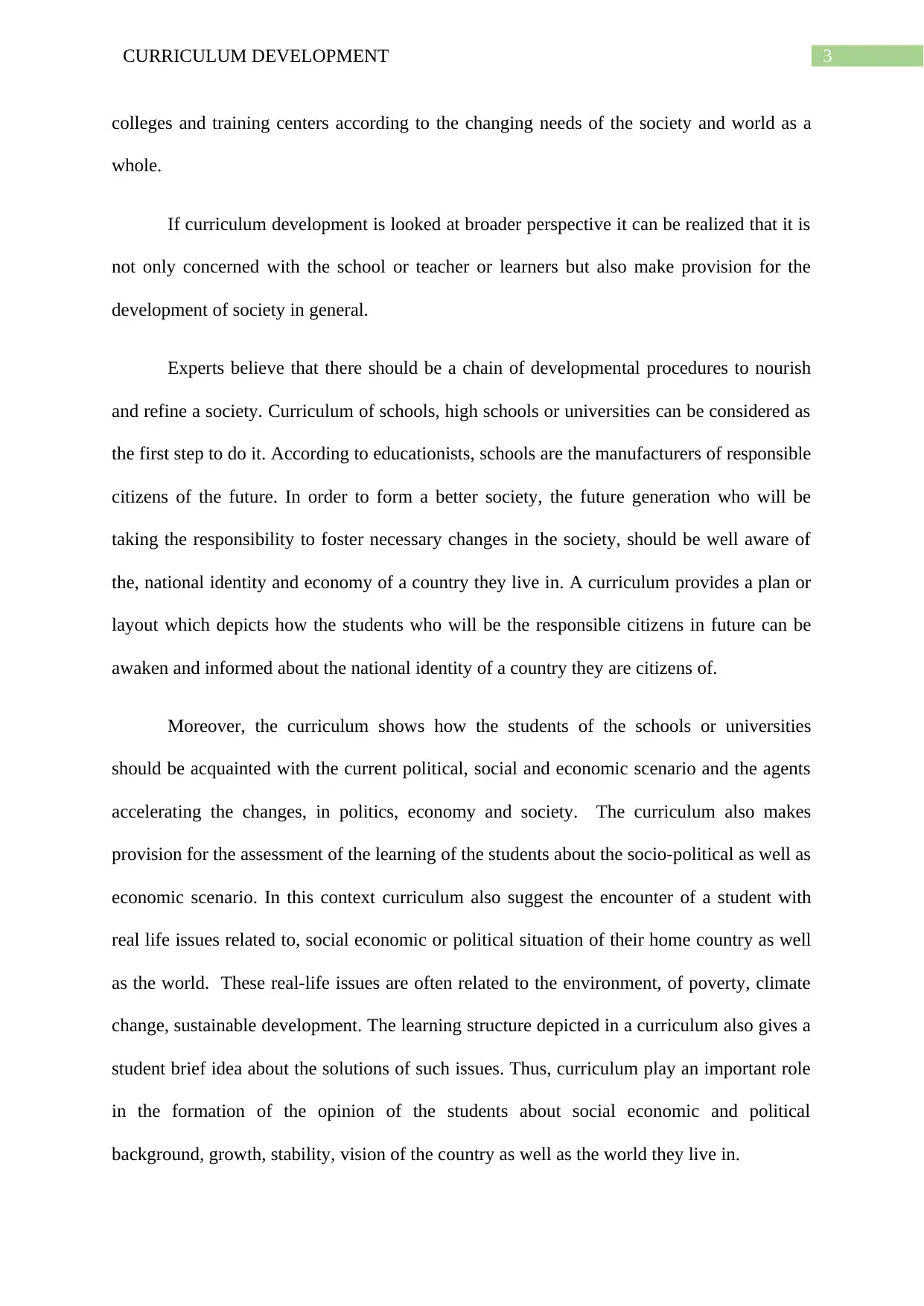
3CURRICULUM DEVELOPMENT
colleges and training centers according to the changing needs of the society and world as a
whole.
If curriculum development is looked at broader perspective it can be realized that it is
not only concerned with the school or teacher or learners but also make provision for the
development of society in general.
Experts believe that there should be a chain of developmental procedures to nourish
and refine a society. Curriculum of schools, high schools or universities can be considered as
the first step to do it. According to educationists, schools are the manufacturers of responsible
citizens of the future. In order to form a better society, the future generation who will be
taking the responsibility to foster necessary changes in the society, should be well aware of
the, national identity and economy of a country they live in. A curriculum provides a plan or
layout which depicts how the students who will be the responsible citizens in future can be
awaken and informed about the national identity of a country they are citizens of.
Moreover, the curriculum shows how the students of the schools or universities
should be acquainted with the current political, social and economic scenario and the agents
accelerating the changes, in politics, economy and society. The curriculum also makes
provision for the assessment of the learning of the students about the socio-political as well as
economic scenario. In this context curriculum also suggest the encounter of a student with
real life issues related to, social economic or political situation of their home country as well
as the world. These real-life issues are often related to the environment, of poverty, climate
change, sustainable development. The learning structure depicted in a curriculum also gives a
student brief idea about the solutions of such issues. Thus, curriculum play an important role
in the formation of the opinion of the students about social economic and political
background, growth, stability, vision of the country as well as the world they live in.
colleges and training centers according to the changing needs of the society and world as a
whole.
If curriculum development is looked at broader perspective it can be realized that it is
not only concerned with the school or teacher or learners but also make provision for the
development of society in general.
Experts believe that there should be a chain of developmental procedures to nourish
and refine a society. Curriculum of schools, high schools or universities can be considered as
the first step to do it. According to educationists, schools are the manufacturers of responsible
citizens of the future. In order to form a better society, the future generation who will be
taking the responsibility to foster necessary changes in the society, should be well aware of
the, national identity and economy of a country they live in. A curriculum provides a plan or
layout which depicts how the students who will be the responsible citizens in future can be
awaken and informed about the national identity of a country they are citizens of.
Moreover, the curriculum shows how the students of the schools or universities
should be acquainted with the current political, social and economic scenario and the agents
accelerating the changes, in politics, economy and society. The curriculum also makes
provision for the assessment of the learning of the students about the socio-political as well as
economic scenario. In this context curriculum also suggest the encounter of a student with
real life issues related to, social economic or political situation of their home country as well
as the world. These real-life issues are often related to the environment, of poverty, climate
change, sustainable development. The learning structure depicted in a curriculum also gives a
student brief idea about the solutions of such issues. Thus, curriculum play an important role
in the formation of the opinion of the students about social economic and political
background, growth, stability, vision of the country as well as the world they live in.
⊘ This is a preview!⊘
Do you want full access?
Subscribe today to unlock all pages.

Trusted by 1+ million students worldwide
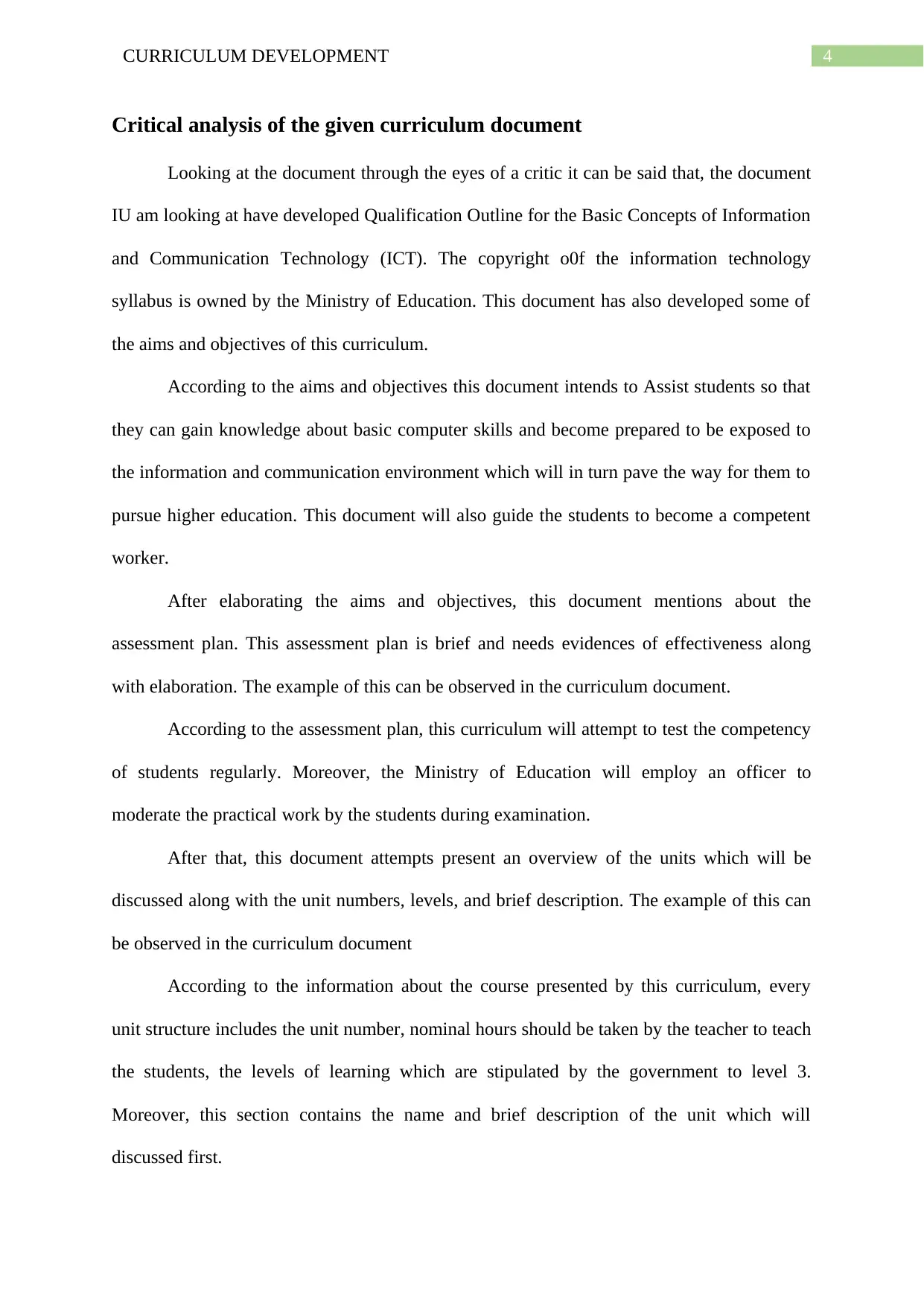
4CURRICULUM DEVELOPMENT
Critical analysis of the given curriculum document
Looking at the document through the eyes of a critic it can be said that, the document
IU am looking at have developed Qualification Outline for the Basic Concepts of Information
and Communication Technology (ICT). The copyright o0f the information technology
syllabus is owned by the Ministry of Education. This document has also developed some of
the aims and objectives of this curriculum.
According to the aims and objectives this document intends to Assist students so that
they can gain knowledge about basic computer skills and become prepared to be exposed to
the information and communication environment which will in turn pave the way for them to
pursue higher education. This document will also guide the students to become a competent
worker.
After elaborating the aims and objectives, this document mentions about the
assessment plan. This assessment plan is brief and needs evidences of effectiveness along
with elaboration. The example of this can be observed in the curriculum document.
According to the assessment plan, this curriculum will attempt to test the competency
of students regularly. Moreover, the Ministry of Education will employ an officer to
moderate the practical work by the students during examination.
After that, this document attempts present an overview of the units which will be
discussed along with the unit numbers, levels, and brief description. The example of this can
be observed in the curriculum document
According to the information about the course presented by this curriculum, every
unit structure includes the unit number, nominal hours should be taken by the teacher to teach
the students, the levels of learning which are stipulated by the government to level 3.
Moreover, this section contains the name and brief description of the unit which will
discussed first.
Critical analysis of the given curriculum document
Looking at the document through the eyes of a critic it can be said that, the document
IU am looking at have developed Qualification Outline for the Basic Concepts of Information
and Communication Technology (ICT). The copyright o0f the information technology
syllabus is owned by the Ministry of Education. This document has also developed some of
the aims and objectives of this curriculum.
According to the aims and objectives this document intends to Assist students so that
they can gain knowledge about basic computer skills and become prepared to be exposed to
the information and communication environment which will in turn pave the way for them to
pursue higher education. This document will also guide the students to become a competent
worker.
After elaborating the aims and objectives, this document mentions about the
assessment plan. This assessment plan is brief and needs evidences of effectiveness along
with elaboration. The example of this can be observed in the curriculum document.
According to the assessment plan, this curriculum will attempt to test the competency
of students regularly. Moreover, the Ministry of Education will employ an officer to
moderate the practical work by the students during examination.
After that, this document attempts present an overview of the units which will be
discussed along with the unit numbers, levels, and brief description. The example of this can
be observed in the curriculum document
According to the information about the course presented by this curriculum, every
unit structure includes the unit number, nominal hours should be taken by the teacher to teach
the students, the levels of learning which are stipulated by the government to level 3.
Moreover, this section contains the name and brief description of the unit which will
discussed first.
Paraphrase This Document
Need a fresh take? Get an instant paraphrase of this document with our AI Paraphraser
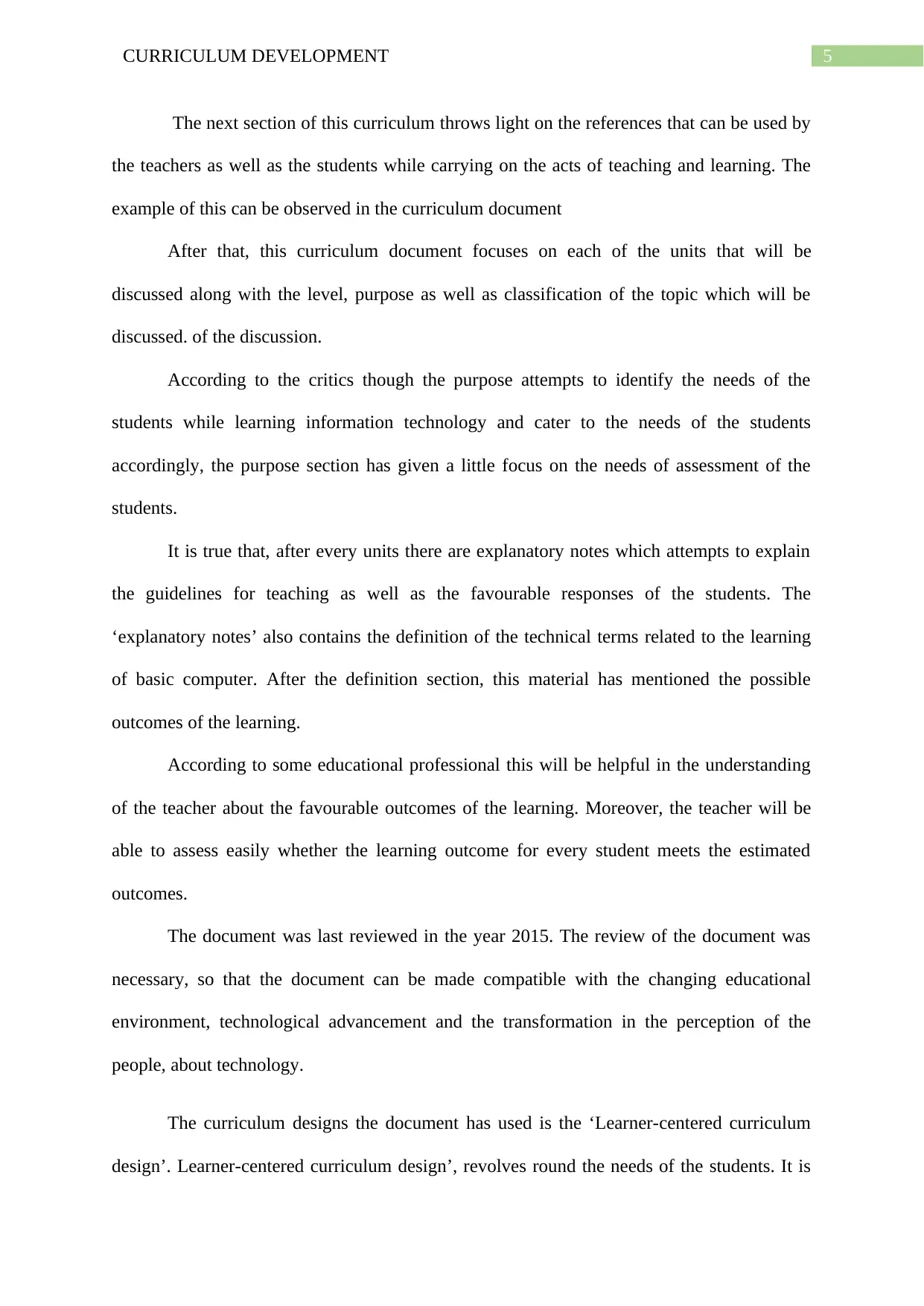
5CURRICULUM DEVELOPMENT
The next section of this curriculum throws light on the references that can be used by
the teachers as well as the students while carrying on the acts of teaching and learning. The
example of this can be observed in the curriculum document
After that, this curriculum document focuses on each of the units that will be
discussed along with the level, purpose as well as classification of the topic which will be
discussed. of the discussion.
According to the critics though the purpose attempts to identify the needs of the
students while learning information technology and cater to the needs of the students
accordingly, the purpose section has given a little focus on the needs of assessment of the
students.
It is true that, after every units there are explanatory notes which attempts to explain
the guidelines for teaching as well as the favourable responses of the students. The
‘explanatory notes’ also contains the definition of the technical terms related to the learning
of basic computer. After the definition section, this material has mentioned the possible
outcomes of the learning.
According to some educational professional this will be helpful in the understanding
of the teacher about the favourable outcomes of the learning. Moreover, the teacher will be
able to assess easily whether the learning outcome for every student meets the estimated
outcomes.
The document was last reviewed in the year 2015. The review of the document was
necessary, so that the document can be made compatible with the changing educational
environment, technological advancement and the transformation in the perception of the
people, about technology.
The curriculum designs the document has used is the ‘Learner-centered curriculum
design’. Learner-centered curriculum design’, revolves round the needs of the students. It is
The next section of this curriculum throws light on the references that can be used by
the teachers as well as the students while carrying on the acts of teaching and learning. The
example of this can be observed in the curriculum document
After that, this curriculum document focuses on each of the units that will be
discussed along with the level, purpose as well as classification of the topic which will be
discussed. of the discussion.
According to the critics though the purpose attempts to identify the needs of the
students while learning information technology and cater to the needs of the students
accordingly, the purpose section has given a little focus on the needs of assessment of the
students.
It is true that, after every units there are explanatory notes which attempts to explain
the guidelines for teaching as well as the favourable responses of the students. The
‘explanatory notes’ also contains the definition of the technical terms related to the learning
of basic computer. After the definition section, this material has mentioned the possible
outcomes of the learning.
According to some educational professional this will be helpful in the understanding
of the teacher about the favourable outcomes of the learning. Moreover, the teacher will be
able to assess easily whether the learning outcome for every student meets the estimated
outcomes.
The document was last reviewed in the year 2015. The review of the document was
necessary, so that the document can be made compatible with the changing educational
environment, technological advancement and the transformation in the perception of the
people, about technology.
The curriculum designs the document has used is the ‘Learner-centered curriculum
design’. Learner-centered curriculum design’, revolves round the needs of the students. It is
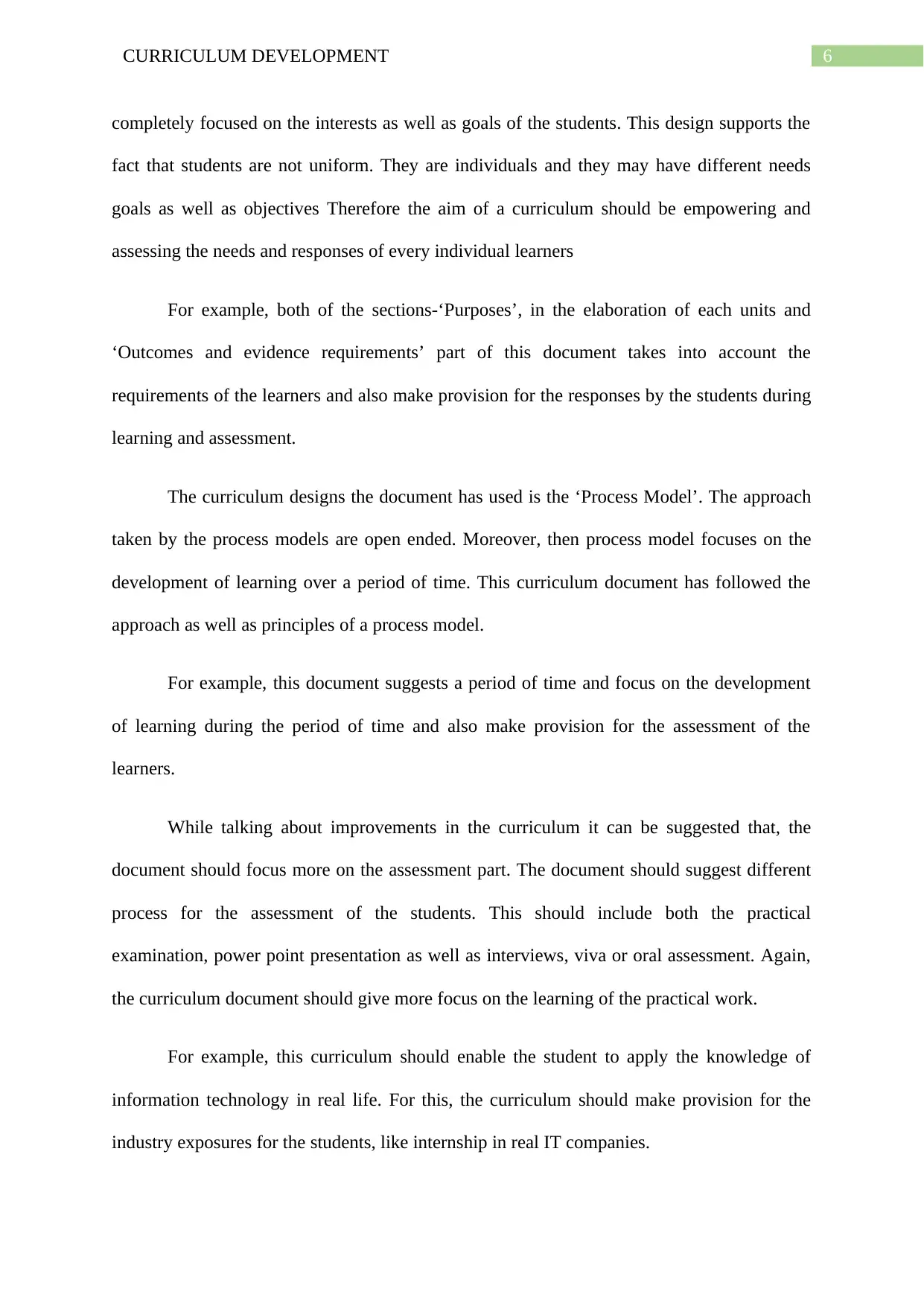
6CURRICULUM DEVELOPMENT
completely focused on the interests as well as goals of the students. This design supports the
fact that students are not uniform. They are individuals and they may have different needs
goals as well as objectives Therefore the aim of a curriculum should be empowering and
assessing the needs and responses of every individual learners
For example, both of the sections-‘Purposes’, in the elaboration of each units and
‘Outcomes and evidence requirements’ part of this document takes into account the
requirements of the learners and also make provision for the responses by the students during
learning and assessment.
The curriculum designs the document has used is the ‘Process Model’. The approach
taken by the process models are open ended. Moreover, then process model focuses on the
development of learning over a period of time. This curriculum document has followed the
approach as well as principles of a process model.
For example, this document suggests a period of time and focus on the development
of learning during the period of time and also make provision for the assessment of the
learners.
While talking about improvements in the curriculum it can be suggested that, the
document should focus more on the assessment part. The document should suggest different
process for the assessment of the students. This should include both the practical
examination, power point presentation as well as interviews, viva or oral assessment. Again,
the curriculum document should give more focus on the learning of the practical work.
For example, this curriculum should enable the student to apply the knowledge of
information technology in real life. For this, the curriculum should make provision for the
industry exposures for the students, like internship in real IT companies.
completely focused on the interests as well as goals of the students. This design supports the
fact that students are not uniform. They are individuals and they may have different needs
goals as well as objectives Therefore the aim of a curriculum should be empowering and
assessing the needs and responses of every individual learners
For example, both of the sections-‘Purposes’, in the elaboration of each units and
‘Outcomes and evidence requirements’ part of this document takes into account the
requirements of the learners and also make provision for the responses by the students during
learning and assessment.
The curriculum designs the document has used is the ‘Process Model’. The approach
taken by the process models are open ended. Moreover, then process model focuses on the
development of learning over a period of time. This curriculum document has followed the
approach as well as principles of a process model.
For example, this document suggests a period of time and focus on the development
of learning during the period of time and also make provision for the assessment of the
learners.
While talking about improvements in the curriculum it can be suggested that, the
document should focus more on the assessment part. The document should suggest different
process for the assessment of the students. This should include both the practical
examination, power point presentation as well as interviews, viva or oral assessment. Again,
the curriculum document should give more focus on the learning of the practical work.
For example, this curriculum should enable the student to apply the knowledge of
information technology in real life. For this, the curriculum should make provision for the
industry exposures for the students, like internship in real IT companies.
⊘ This is a preview!⊘
Do you want full access?
Subscribe today to unlock all pages.

Trusted by 1+ million students worldwide
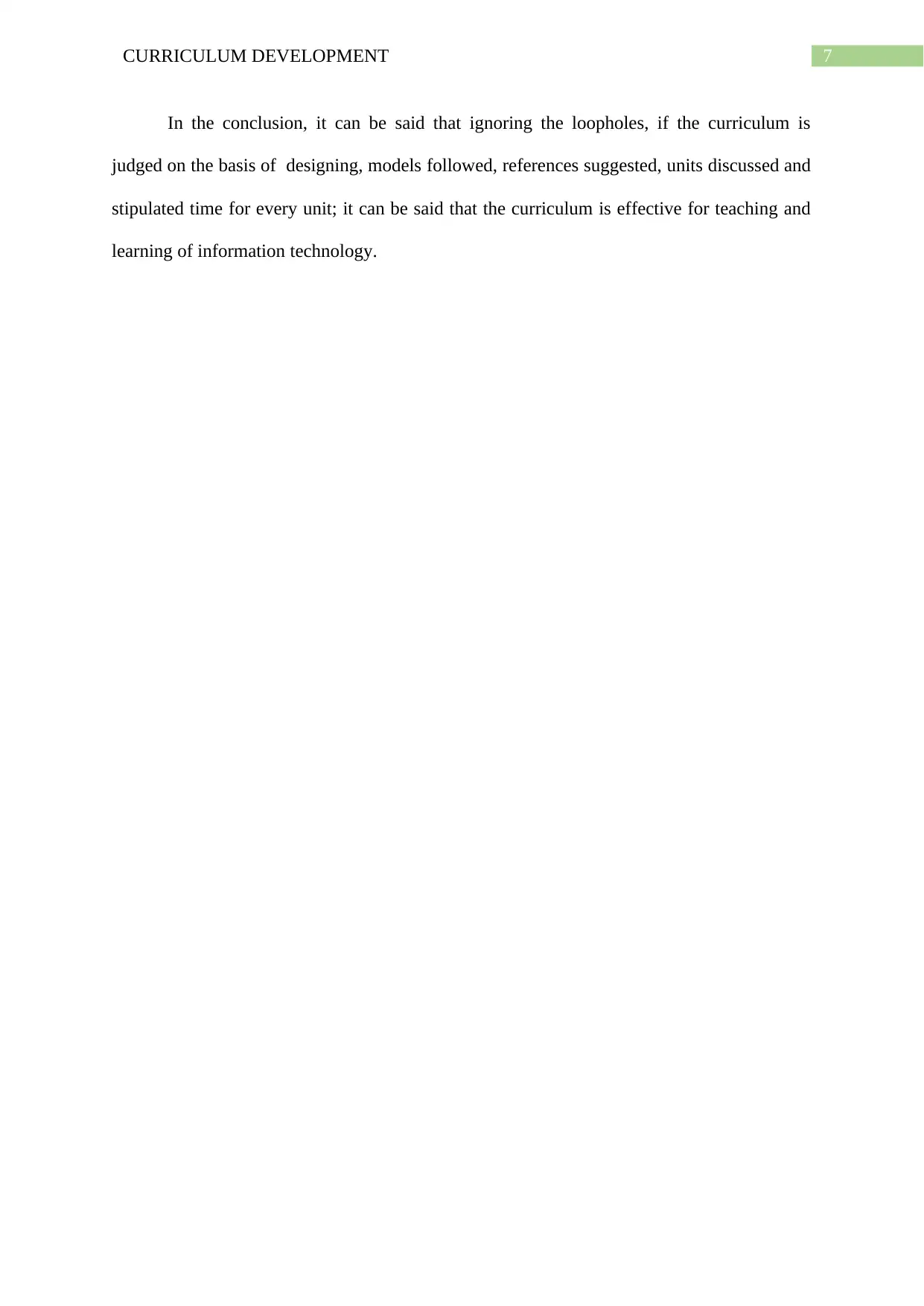
7CURRICULUM DEVELOPMENT
In the conclusion, it can be said that ignoring the loopholes, if the curriculum is
judged on the basis of designing, models followed, references suggested, units discussed and
stipulated time for every unit; it can be said that the curriculum is effective for teaching and
learning of information technology.
In the conclusion, it can be said that ignoring the loopholes, if the curriculum is
judged on the basis of designing, models followed, references suggested, units discussed and
stipulated time for every unit; it can be said that the curriculum is effective for teaching and
learning of information technology.
Paraphrase This Document
Need a fresh take? Get an instant paraphrase of this document with our AI Paraphraser
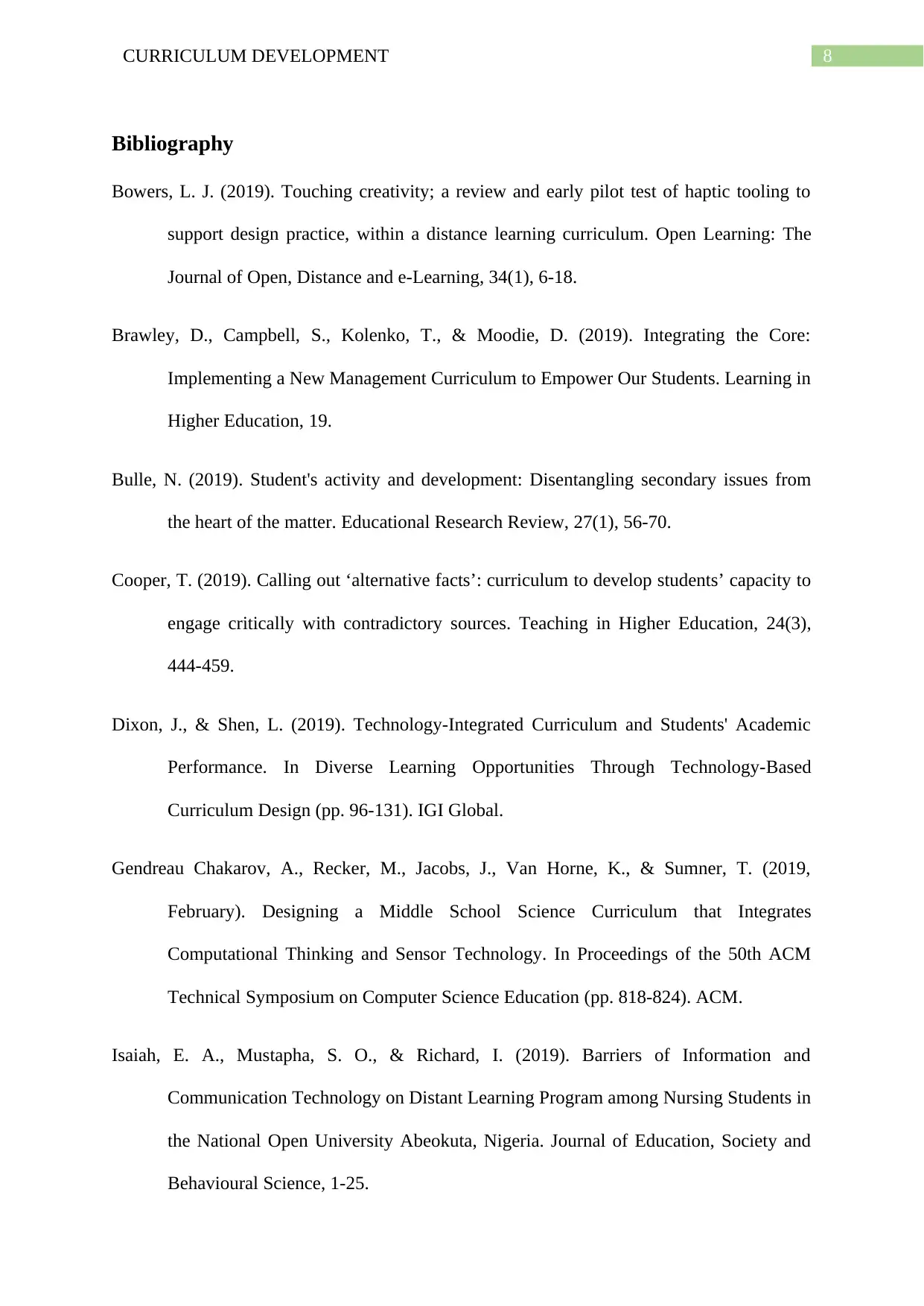
8CURRICULUM DEVELOPMENT
Bibliography
Bowers, L. J. (2019). Touching creativity; a review and early pilot test of haptic tooling to
support design practice, within a distance learning curriculum. Open Learning: The
Journal of Open, Distance and e-Learning, 34(1), 6-18.
Brawley, D., Campbell, S., Kolenko, T., & Moodie, D. (2019). Integrating the Core:
Implementing a New Management Curriculum to Empower Our Students. Learning in
Higher Education, 19.
Bulle, N. (2019). Student's activity and development: Disentangling secondary issues from
the heart of the matter. Educational Research Review, 27(1), 56-70.
Cooper, T. (2019). Calling out ‘alternative facts’: curriculum to develop students’ capacity to
engage critically with contradictory sources. Teaching in Higher Education, 24(3),
444-459.
Dixon, J., & Shen, L. (2019). Technology-Integrated Curriculum and Students' Academic
Performance. In Diverse Learning Opportunities Through Technology-Based
Curriculum Design (pp. 96-131). IGI Global.
Gendreau Chakarov, A., Recker, M., Jacobs, J., Van Horne, K., & Sumner, T. (2019,
February). Designing a Middle School Science Curriculum that Integrates
Computational Thinking and Sensor Technology. In Proceedings of the 50th ACM
Technical Symposium on Computer Science Education (pp. 818-824). ACM.
Isaiah, E. A., Mustapha, S. O., & Richard, I. (2019). Barriers of Information and
Communication Technology on Distant Learning Program among Nursing Students in
the National Open University Abeokuta, Nigeria. Journal of Education, Society and
Behavioural Science, 1-25.
Bibliography
Bowers, L. J. (2019). Touching creativity; a review and early pilot test of haptic tooling to
support design practice, within a distance learning curriculum. Open Learning: The
Journal of Open, Distance and e-Learning, 34(1), 6-18.
Brawley, D., Campbell, S., Kolenko, T., & Moodie, D. (2019). Integrating the Core:
Implementing a New Management Curriculum to Empower Our Students. Learning in
Higher Education, 19.
Bulle, N. (2019). Student's activity and development: Disentangling secondary issues from
the heart of the matter. Educational Research Review, 27(1), 56-70.
Cooper, T. (2019). Calling out ‘alternative facts’: curriculum to develop students’ capacity to
engage critically with contradictory sources. Teaching in Higher Education, 24(3),
444-459.
Dixon, J., & Shen, L. (2019). Technology-Integrated Curriculum and Students' Academic
Performance. In Diverse Learning Opportunities Through Technology-Based
Curriculum Design (pp. 96-131). IGI Global.
Gendreau Chakarov, A., Recker, M., Jacobs, J., Van Horne, K., & Sumner, T. (2019,
February). Designing a Middle School Science Curriculum that Integrates
Computational Thinking and Sensor Technology. In Proceedings of the 50th ACM
Technical Symposium on Computer Science Education (pp. 818-824). ACM.
Isaiah, E. A., Mustapha, S. O., & Richard, I. (2019). Barriers of Information and
Communication Technology on Distant Learning Program among Nursing Students in
the National Open University Abeokuta, Nigeria. Journal of Education, Society and
Behavioural Science, 1-25.
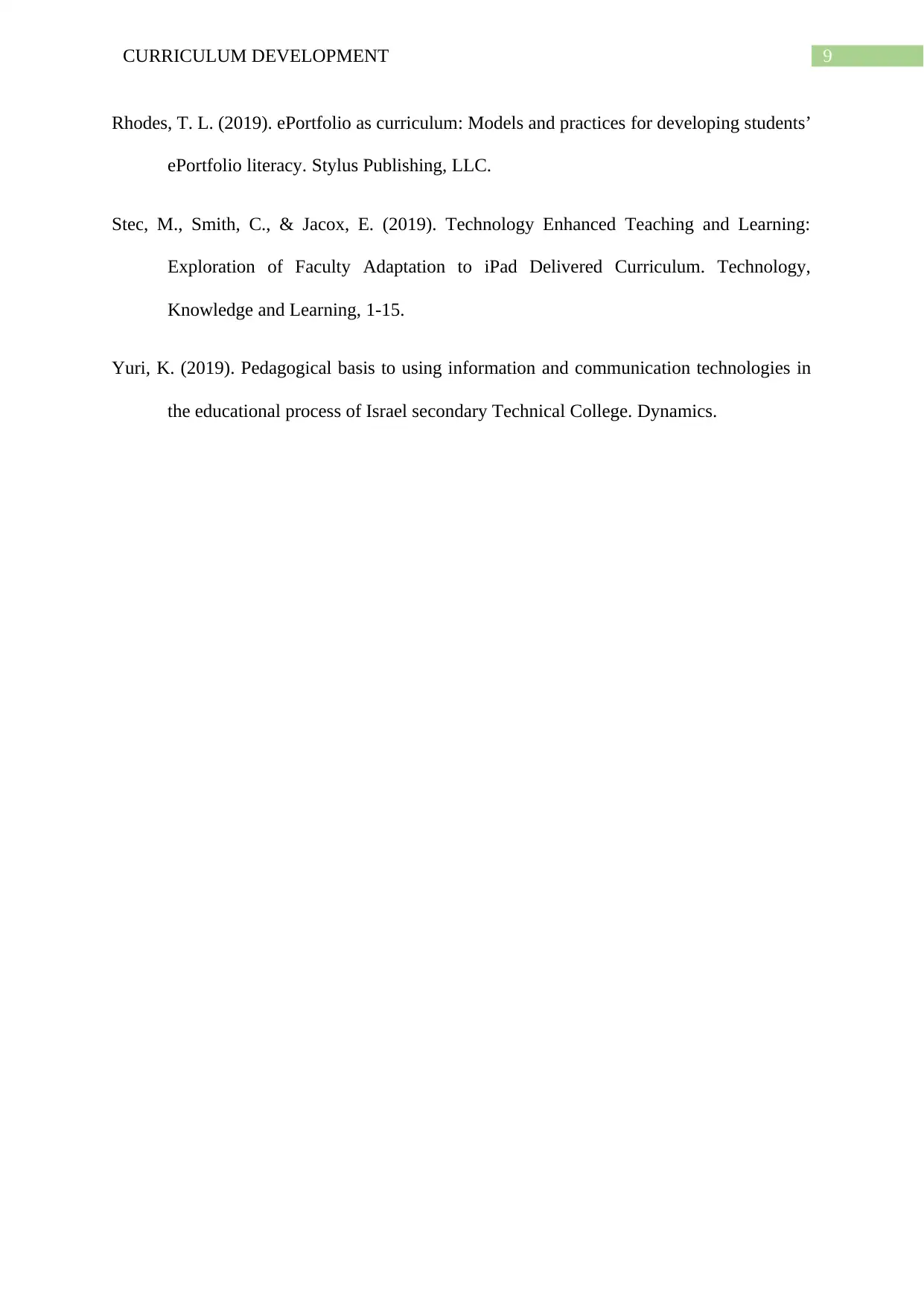
9CURRICULUM DEVELOPMENT
Rhodes, T. L. (2019). ePortfolio as curriculum: Models and practices for developing students’
ePortfolio literacy. Stylus Publishing, LLC.
Stec, M., Smith, C., & Jacox, E. (2019). Technology Enhanced Teaching and Learning:
Exploration of Faculty Adaptation to iPad Delivered Curriculum. Technology,
Knowledge and Learning, 1-15.
Yuri, K. (2019). Pedagogical basis to using information and communication technologies in
the educational process of Israel secondary Technical College. Dynamics.
Rhodes, T. L. (2019). ePortfolio as curriculum: Models and practices for developing students’
ePortfolio literacy. Stylus Publishing, LLC.
Stec, M., Smith, C., & Jacox, E. (2019). Technology Enhanced Teaching and Learning:
Exploration of Faculty Adaptation to iPad Delivered Curriculum. Technology,
Knowledge and Learning, 1-15.
Yuri, K. (2019). Pedagogical basis to using information and communication technologies in
the educational process of Israel secondary Technical College. Dynamics.
⊘ This is a preview!⊘
Do you want full access?
Subscribe today to unlock all pages.

Trusted by 1+ million students worldwide
1 out of 9
Related Documents
Your All-in-One AI-Powered Toolkit for Academic Success.
+13062052269
info@desklib.com
Available 24*7 on WhatsApp / Email
![[object Object]](/_next/static/media/star-bottom.7253800d.svg)
Unlock your academic potential
Copyright © 2020–2025 A2Z Services. All Rights Reserved. Developed and managed by ZUCOL.





